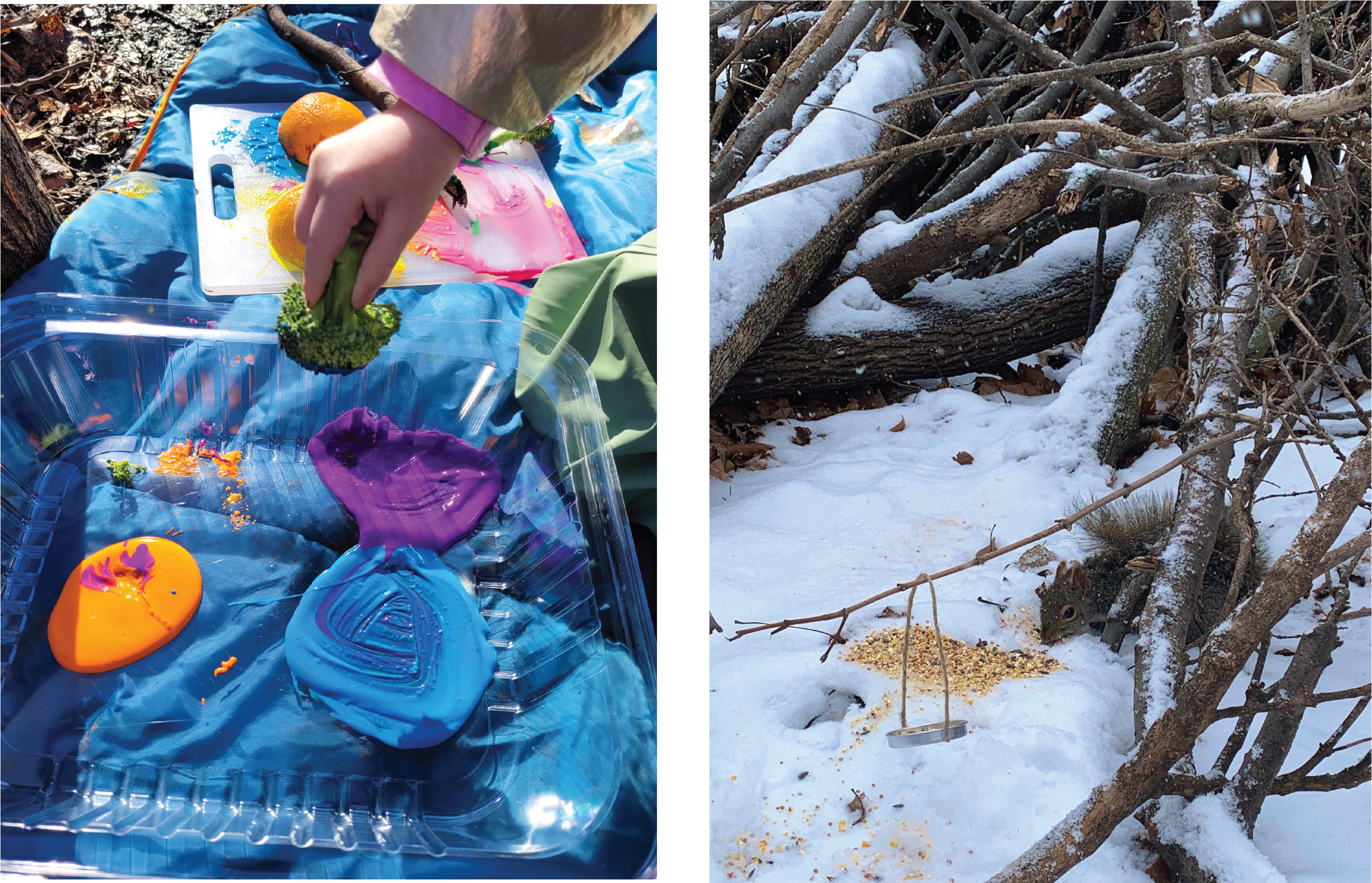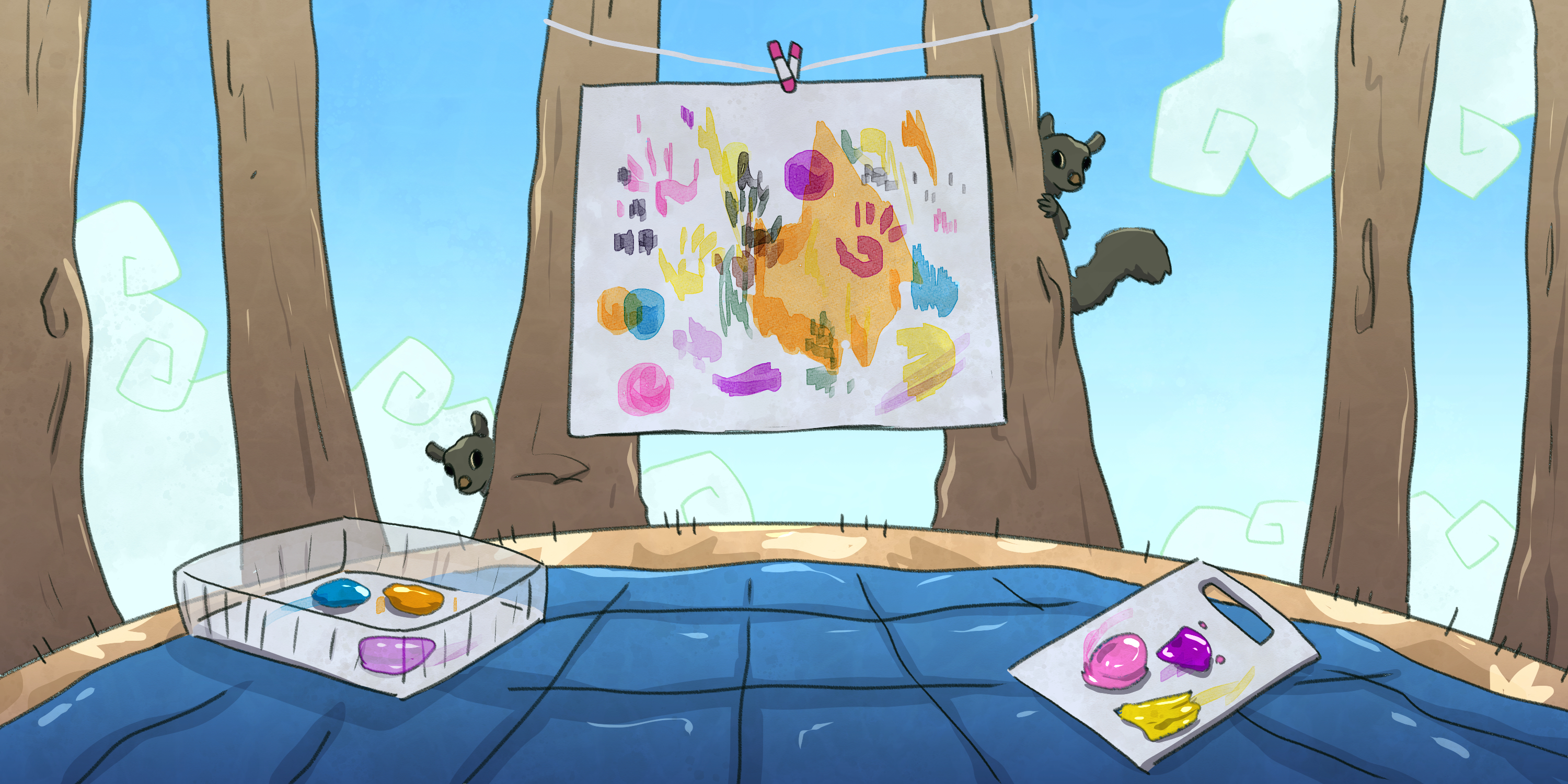Kasey Johnson started the Growing Gardeners Club as a fun way for children to experience the environment
Had it been a week earlier, the park would have looked entirely different.
“Last week, we were all wearing snow pants,” says Growing Gardener’s Club founder Kasey Johnson, as she ties a string of yarn to stabilize a blank poster board against a tree. “Now, it’s like spring is here!”
The early morning sun casts a spotlight on Johnson’s corner of the park. Slightly obscured from the main paths of Horner Park, the only indication of anything out of the ordinary going on is the two robot statues framing the entrance to where Johnson is setting up activities.
A cart near Johnson is stacked with empty bowls, whisks and spoons — perfect for the formation of “mud soup.” A container of small flower pots rests atop a stump, with a large bag of soil and cat grass seeds leaning against it. On a stump on the other side of the circle rests a pink tub with a squirrel devouring birdseed. Beneath Johnson’s poster board lie two paint palettes next to broccoli pieces and halves of a grapefruit.
“Basically, the kids can use the food to paint, or they can create a ‘nature paintbrush,’” says Johnson, as she ties a small pinecone to the end of the stick to demonstrate her own “nature paintbrush.” “I used to do this when I taught preschool.”
Johnson is setting up these stations for the Growing Gardeners Club’s third meeting. She started the club in late January after seeing that Horner Park would be the perfect place to create an outdoor education group for children. After posting a flyer on Facebook, the group took off.
“Being in Chicago, we’re fortunate to have a lot of access to greenery, but it’s something that I think kids really need to seek out,” says Johnson. “You don’t need much, you just need each other and a place to go.”

Growing Gardener’s Club founder Kasey Johnson poses in front of some equipment. She started the outdoor education club for children in January. Photo courtesy of Kasey Johnson
From the distance, the soft rustling of squirrels darting around the trees is interrupted by the loud crunch of leaves and infectious giggling that steadily grows closer. Two young boys run toward Johnson, nearly tripping over their own feet. Behind them, each of their moms smile as they talk with each other.
“Hey, guys!” Johnson says, smiling as she walks over to the bin of birdseed. “Do you want to feed some squirrels?”
Those are the magic words. The boys rush to peer into the bin as Johnson explains how squirrels love to eat birdseed, and that there are a lot of squirrels in this area. She points to her right and tells the kids that a lot of squirrels seemed to be hanging out near the gathering of branches. The eager children each grab a handful of the seed and rush to the teepee-shaped collection of branches where squirrels dart in and out.
“Squirrels! Hey, squirrels!” the boys shout, tossing their handfuls of seed into the branches and watching it scatter onto the ground. They rush back to the bin to grab more, howling with laughter.
“My grandma had a garden in her backyard in Iowa,” Johnson had mentioned a few days before the meeting. She and her grandma had a close bond, she said, and her grandma’s favorite thing to do was feed the squirrels.
Johnson’s life has revolved around nature. She spent her childhood outside with neighbors, making magic wands out of sticks and throwing tea parties for worms. As she grew older, she worked at two national parks and researched gardening.
“I was going through a really hard time in my life,” Johnson said. “I really found that nature was such a healing part for me and how much it improved my mental health as an adult.”
Her passion for nature led her to be a gardener at a preschool after graduating college. She ended up leaving teaching but never lost her love for working with children and nature.

Left: A student uses broccoli to paint during one of the outdoor activities. Right: A squirrel approaches seeds the children threw for it to eat. Photos courtesy of Kasey Johnson
As the seeds decrease, Johnson seamlessly transitions into the other activities she set up. She describes how to plant cat grass and its benefits for cats’ stomachs. She plays along when a child asks if his stuffed animal could have a nibble. She explains how to paint using the pieces of broccoli and grapefruit and how tying something interesting to a stick can create a paintbrush. She pulls out the bowls and spoons, encouraging the children to make their own mud soup. The wide-eyed children never stop moving, rotating from one activity to the next.
“He turns three in a week,” says one parent, as her son scribbles with a grapefruit on the poster. “He has a lot of energy, so it’s good to bring him outside.”
“Look,” the boy says as he turns to his mom and points to his scribbles. “Now, it’s a baby lion!”
Johnson has noticed the change in behavior children exhibit when they come outside. During her teaching years, she observed that children who were normally hyperactive would become calm once they began interacting with nature.
“I think a child’s connection with nature is so important for them, for navigating relationships, for gaining self-confidence, for stimulating their curiosity,” Johnson said. “It is such a joy to watch a kid come to the club and pick up a stick and, all of a sudden, he’s transformed into a whole world.”
Johnson weaves from one activity to another without breaking a sweat. She plants cat grass seeds for one child, refills the paint for the boy and his baby lion, and creates impromptu mud from her bag of soil and water bottle. Her brilliant smile never leaves her face.
A child runs up to her, practically shaking with excitement. “Look at all the birdseed I got!”
Johnson stops planting cat grass for a moment. Her face lights up at his words, and she bends down.
“Woah, let’s see!”
He opens his hand to present the seeds sticking to his palm. Johnson gasps in amazement at the sight. There is an unspoken understanding between them, one that passes through them and the other children currently painting and throwing seeds and assembling mud soup. It is the knowledge of how big this moment is for them, to be outside and connecting with nature. The boy closes his fist and rushes to the branches once more.
“The simple things in life and the simplicity of nature are really beautiful,” Johnson said. “The importance of nature has been so beneficial in my life that I just want children to be able to have that place of, not only fun and enjoyment, but healing for their future selves.”
Header Illustration by Julia Hester




NO COMMENT